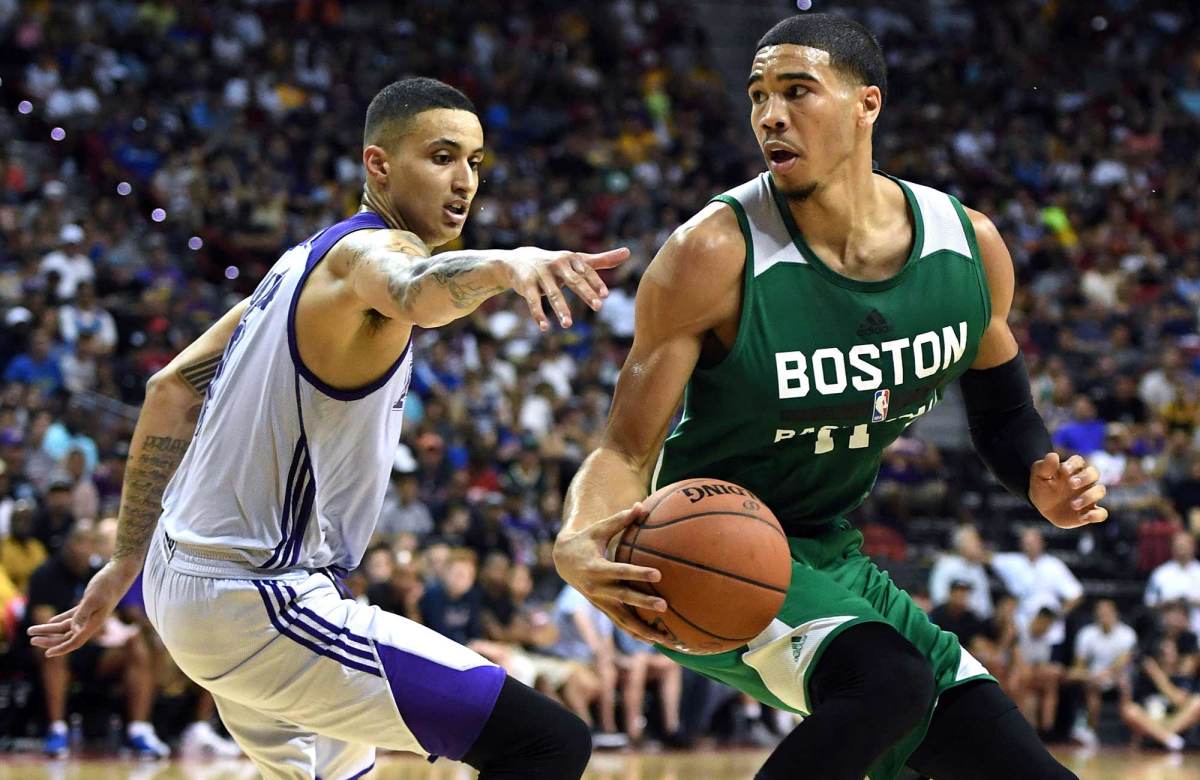How Does Jayson Tatum Fit Into Boston's Big Picture?

LAS VEGAS — Jayson Tatum has lost his balance. He is crowded, again, as he begins his face-up move, as is the case for so many scorers in the Las Vegas Summer League. Lineups are not balanced well enough to keep the floor spaced properly. Teammates are so unfamiliar with one another that they cannot help but get in the way. None of this seems to bother Tatum, who feints and pivots and ekes out a shot over an encroaching defender.
The shot goes down because this is what Tatum does. Touch and skill bubble to the surface whenever he has the ball. Even when Tatum isn’t able to blow past his man, smart footwork and a high release point can often take his moves to their natural conclusion. Already he seems to have a promising future as a contested shot-maker—a skill that makes the life of a young player dramatically easier.
“He makes tough shots, something that’s hard to do at the next level,” says Jaylen Brown, Tatum’s Celtics teammate. “Playing in the NBA is going to be hard, but he’s a shot-maker and that makes it easy for everybody when he’s scoring the ball.” Tatum, in that way, is almost a perfect summer leaguer. His game is so freely translatable that it can work almost independently of what goes on around him. He averaged 18.7 points in his three games in Salt Lake City and dropped a game-high 27 points on the Lakers in Las Vegas on Sunday.
Paul George On OKC, The Trade, And KD's Advice
Boston’s actual offense, however, is largely an exercise in codependence. Isaiah Thomas stepped into a different world once he started looping around pre-planned screens before even receiving the ball. Every move, then, came as an extension of something. That sort of connectivity puts a defender (or even multiple defenders) behind the action once it really begins, stretching what an offensive player already does well to its fluid fullest.
What capacity Tatum has to fall into that kind of offense remains to be seen. The style of play in Vegas only vaguely resembles NBA basketball. Rarely is it close enough to be predictive. It’s not just the quality of competition that shifts but its entire context; the things Tatum will be asked to do for the Celtics during the NBA season will come through entirely different means than what he is asked to do in Summer League. Ability translates, and Tatum clearly has it. Nineteen-year-olds rarely have such depth to their bag of tricks and almost never understand how to combine those tricks as well as Tatum does. “Precocious” seems like an understatement.

Many wings—especially those undersized—will not be able to take away the shots that Tatum works diligently to get to. In question is Boston’s appetite for those looks in the first place, particularly when so much of Tatum’s game seems outside both the rhythm and space of what the Celtics try to accomplish.
It should be noted that this is not, in itself, a bad thing. Motion-heavy offenses can benefit from more straightforward alternatives. The highest-magnitude example of this exists in Golden State, where Kevin Durant transitions smoothly from a working cog in the machine to isolating pointedly as a scorer. The Warriors, talented as they are, need this. Having a player who can create a high-value shot from nothing is part of the undercurrent that makes Golden State so unguardable. Junk up the defense and Durant will roast mismatched defenders. Guard the Warriors in any kind of traditional scheme and their combination of movement and shooting will pull the defense apart. There were never any easy answers for guarding the Warriors before Durant and now there may be no real, lasting answers at all.
Boston is not Golden State and Tatum—a rookie who has yet to play an actual NBA game—is so clearly not Durant. Still, similar principles can apply when an isolation talents finds his way to a well-spaced team accustomed to a lot of player movement. Tatum wouldn’t immediately be the sort of option that could break outside of the offense for a needed score, but perhaps he could grow into it. Where Durant is the gold standard, Tatum might someday play as a less precious parallel.
The path toward making Tatum a targeted weapon against second units, for starters, seems clear enough—if still without any real guarantee. Less defined is the task of translating Tatum’s knack for scoring and his understanding of angles to practical work away from the ball. Tatum isn’t a good enough long-range shooter, regardless of what position he plays, to stand still on the perimeter. One can forgive that temptation in the gummed up offenses of Summer League, but Tatum will need to rewire some of his offense for the sake of Boston’s bigger picture.
The draft works best for teams when they target the top talent available. Tatum, in the Celtics’ estimation, seems to be that. But drafting in this way isn’t without its quirks—challenges that go well beyond the clutter on a depth chart. There is friction between the Summer League standout Tatum is now and the kind of contributor Boston typically prefers. Given further refinement, that difference could be molded into something useful. From distinction comes opportunity. That Tatum doesn’t always operate like a typical Celtic means that few other Celtics—even the many other combo forwards—can do what he does.
